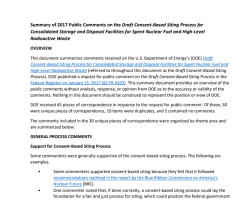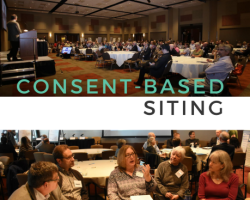Category of Content
Siting Experience Documents Only
Publication Date
Subject Matter
Corrosion-Resistant Coatings for Mitigation and Repair of Spent Nuclear Fuel Dry Storage Canisters
Corrosion-Resistant Coatings for Mitigation and Repair of Spent Nuclear Fuel Dry Storage Canisters
U.S. Department of Energy’s Equity Action Plan
U.S. Department of Energy’s Equity Action Plan
The Department of Energy (hereinafter DOE or the Department) is responsible for ensuring the Nation’s security and prosperity by addressing its energy, environmental and nuclear challenges through transformative science and technology solutions. DOE maintains the Nation’s nuclear weapons stockpile, reduces the threat of nuclear proliferation, oversees the Nation’s energy supply, leads the Nation in areas of federally sponsored basic research critical to U.S.
Model Guidelines for Public Participation: An Update to the 1996 NEJAC Model Plan for Public Participation
Model Guidelines for Public Participation: An Update to the 1996 NEJAC Model Plan for Public Participation
In 1996, the National Environmental Justice Advisory Council (NEJAC or the Council), through its Public Participation and Accountability Subcommittee, worked with the U.S. Environmental Protection Agency (EPA) Office of Environmental Justice (OEJ) to develop the Model Plan for Public Participation (Model Plan). The Model Plan outlined critical elements for conducting public participation and identified core values and guiding principles for the practice of public participation. It was published as a “living document” that would be reviewed and revised as necessary.
Communicating Risks and Benefits: An Evidence-Based User's Guide
Communicating Risks and Benefits: An Evidence-Based User's Guide
Effective risk communication is essential to the well-being of any organization and those people who depend on it. Ineffective communication can cost lives, money, and reputations. Communicating Risks and Benefits: An Evidence-Based User's Guide provides the scientific foundations for effective communication.
Summary of 2017 Public Comments on the Draft Consent-Based Siting Process for Consolidated Storage and Disposal Facilities for Spent Nuclear Fuel and High-Level Radioactive Waste
Summary of 2017 Public Comments on the Draft Consent-Based Siting Process for Consolidated Storage and Disposal Facilities for Spent Nuclear Fuel and High-Level Radioactive Waste
This document summarizes comments received on the U.S. Department of Energy’s (DOE) Draft Consent-Based Siting Process for Consolidated Storage and Disposal Facilities for Spent Nuclear Fuel and High-Level Radioactive Waste (referred to throughout this document as the Draft Consent-Based Siting Process). DOE published a request for public comment on the Draft Consent-Based Siting Process in the Federal Register on January 13, 2017 (82 FR 4333).
Designing a Consent-Based Siting Process: Summary of Public Input, Final Report
Designing a Consent-Based Siting Process: Summary of Public Input, Final Report
The successful siting of nuclear waste management facilities, through a consent-based process, is predicated on a robust and transparent dialogue between the Department and its stakeholders. From December 23, 2015 through July 31, 2016, DOE solicited and received public comments and heard input from a wide range of individuals, communities, states, Tribes, and stakeholders through the multiple avenues described above.
Strategy for the Management and Disposal of Used Nuclear Fuel and High-Level Radioactive Waste 3
Strategy for the Management and Disposal of Used Nuclear Fuel and High-Level Radioactive Waste 3
The Strategy for the Management and Disposal of Used Nuclear Fuel and High-Level Radioactive Waste is a framework for moving toward a sustainable program to deploy an integrated system capable of transporting, storing, and disposing of used nuclear fuel1 and high-level radioactive waste from civilian nuclear power generation, defense, national security and other activities. The Strategy addresses several important needs.


